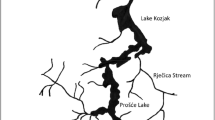Abstract
Lakes and forests are as important to humans as they are providers of drinking water, fish, berries, mushroom, game, and wood. Following the Chernobyl accident, these semi-natural ecosystems have exhibited persistently high contamination levels of radiocaesium, also in the prealpine region of southern Germany. For the past 12 years, the time-dependency of the bioavailability of radiocaesium has been studied for different lakes and forests in order to get an understanding of the persistence and the migration of radiocaesium in semi-natural environments and for radiation protection purposes. As a measure of the time-dependency, the effective half-time and the ecological half-time will be discussed for Cs-137 concentrations and for Cs-137 aggregated transfer factors, respectively.
Access this chapter
Tax calculation will be finalised at checkout
Purchases are for personal use only
Preview
Unable to display preview. Download preview PDF.
Similar content being viewed by others
References
Kaminski, S.; Richter, T.; Walser, M.; Lindner, G. Redissolution of cesium radionuclides from sediments of freshwater lakes due to biological degradation of organic matter. Radiochimica Acta 66/67 (1994), 433–436.
Sansone, U.; Voitsekhovitch, O.; Eds. Modeling and study of the mechanisms of the transfer of radioactive material from terrestrial ecosystems to and in water bodies around Chemobyl. Final report EUR 16529 EN. Brussels, Luxembourg (1996), p.93
Robbins, J. A.; Lindner, G.; Pfeiffer, W.; Kleiner, J.; Stabel, H. H.; Frenzel, P. Epilimnetic scavenging and fate of Chernobyl radionuclides in Lake Constance. Geochim. Cosmochim. Acta 56 (1992), 2339.
Mangini, A; Christian, U.; Barth, M.; Schmitz, W.; Stabel, H. H. Pathways and residence times of radiotracers in Lake Constance, in M. M. Tilzer and C. Serruya (Eds.), Large Lakes, Ecological Structure and Function, Springer Verlag, Berlin (1990), 245–264
Santschi, P. H.; Bollhalder, S.; Zingy, S.; Luck, A; Farrenkother, K. The self cleaning capacity of surface waters after radionuclide fallout. Evidence from European lakes after Chernobyl 1986–88. Environ. Sci.Technol. 24 (1990), 519–527.
Smith, J. T.; Leonard, D. R. P.; Hilton, J.; Appleby, P. G. Towards a generalized model for the primary and secondary contamination of lakes by Chernobyl-derived radiocesium. Health Phys. 72(6) (1997), 880–892.
De Haan, F.AM.; Bolt, G. H.; Pieters, B. G. M. Diffusion of Potassium-40 into an illite during prolonged shaking. Soil Science Society Proceedings 29 (1965), 528–530
Smith, J. T.; Fesenko, S. V.; Howard, B. J.; Horrill, A. D.; Sanzharova, N. I.; Alexakhin, R. M.; Elder, D. G.; Naylor, C., Temporal change in fallout 137Cs in terrestrial and aquatic systems: A whole ecosystem approach and Zibold, G.; FSrschner, A.; Drissner, J.; Klemt, E.; Miller, R.; Walser, M. Time-dependency of the Cs-137 concentration factor in pike from lake Vorsee. UIR Topical Meeting Mol, Belgium, 1.-5. June 1998, to be published in proceedings
Drissner, J.; Bürmann, W.; Enslin, F.; Heider, R.; Klemt, E.; Miller, R.; Schick, G.; Zibold, G. Availability of Cesium Radionuclides for Plants - Classification of Soils and Role of Mycorrhiza. J. of Environ. Radioecology (1998), in press.
Kiefer, P.; Prôhl, G.; Müller, H.; Lindner, G.; Drissner, J.; Zibold, G. Factors affecting the transfer of radiocaesium from soil to roe deer in forest ecosystems of Southern Germany. Sci. Total. Environ. 192 (1996), 49–61.
Klemt, E.; Drissner, J.; Flügel, V.; Kaminski, S.; Lindner, G.; Walser, M.; Zibold, G. Bioavailability of Cesium Radionuclides in Prealpine Forests and Lakes. Mitt. der Österr. Bodenkundl. Ges. 54 (1996), 267–274.
Author information
Authors and Affiliations
Editor information
Editors and Affiliations
Rights and permissions
Copyright information
© 1999 Springer Science+Business Media Dordrecht
About this chapter
Cite this chapter
Klemt, E., Drissner, J., Kaminski, S., Miller, R., Zibold, G. (1999). Time-Dependency of the Bioavailability of Radiocaesium in Lakes and Forests. In: Linkov, I., Schell, W.R. (eds) Contaminated Forests. NATO Science Series, vol 58. Springer, Dordrecht. https://doi.org/10.1007/978-94-011-4694-4_10
Download citation
DOI: https://doi.org/10.1007/978-94-011-4694-4_10
Publisher Name: Springer, Dordrecht
Print ISBN: 978-0-7923-5739-1
Online ISBN: 978-94-011-4694-4
eBook Packages: Springer Book Archive




